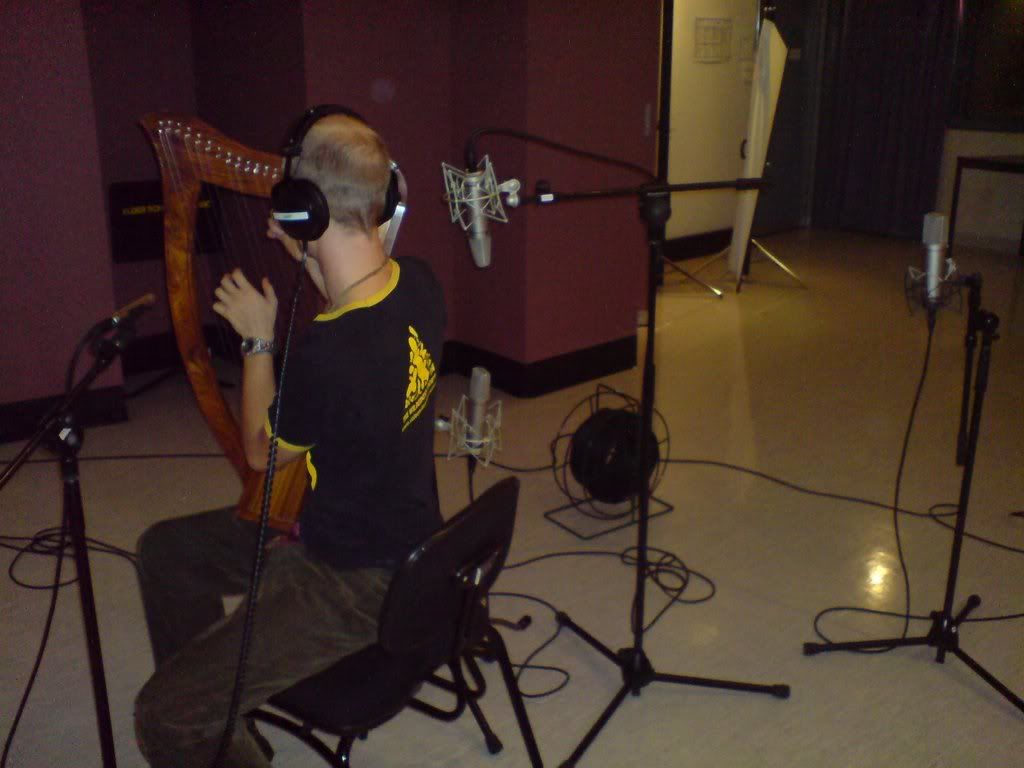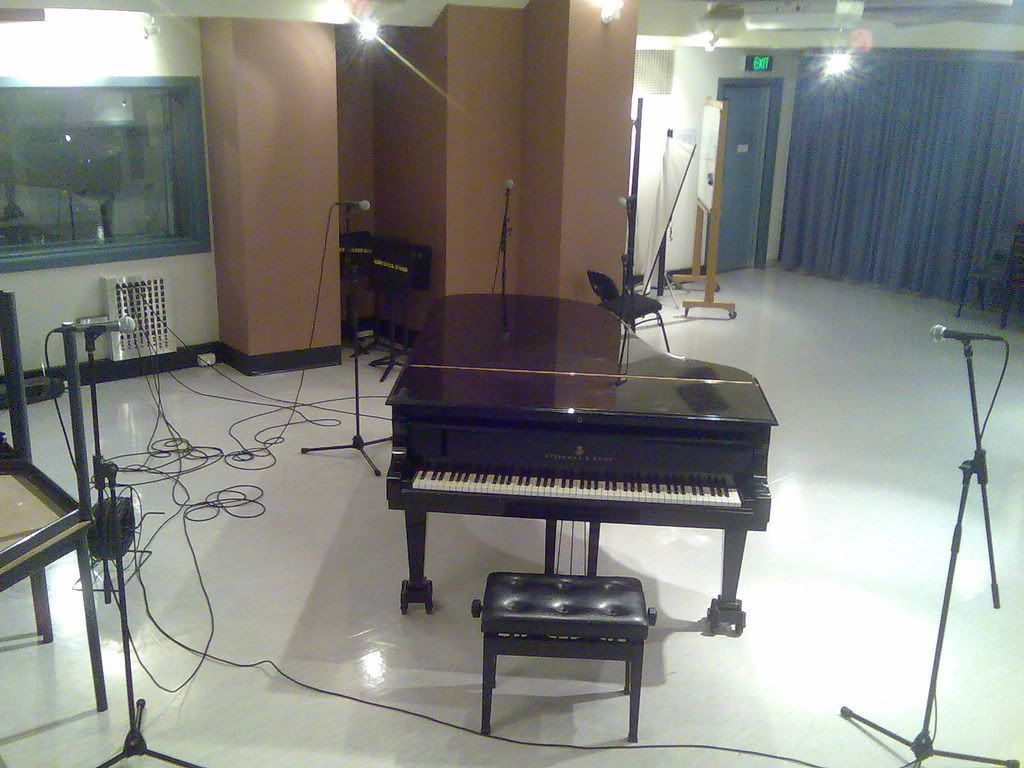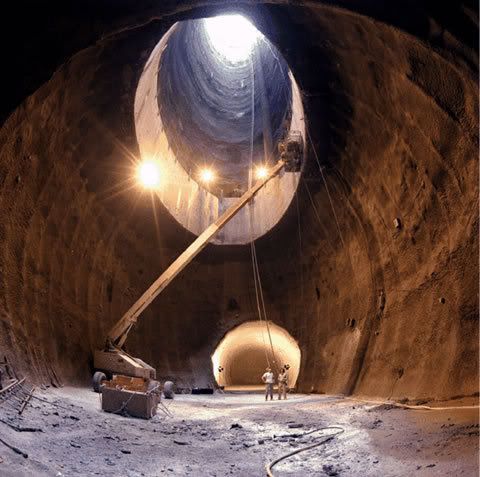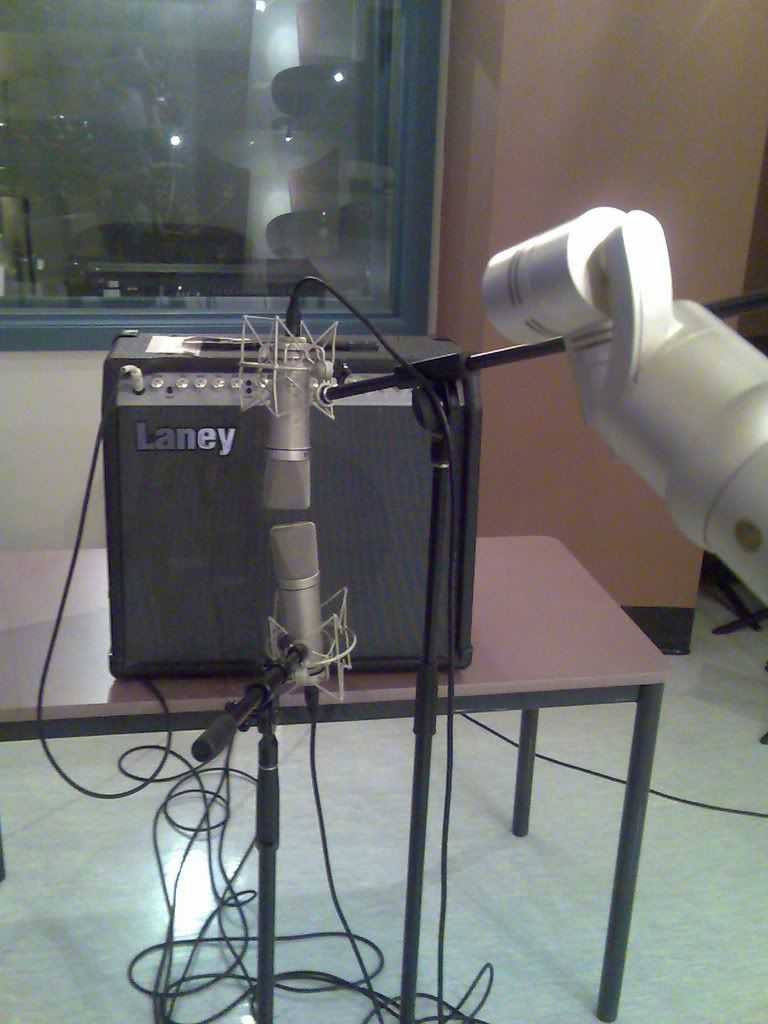Week 4 Forum - Presentations II
This week I presented some music I have been working on this year. The only finished track was the first song I played, which unfortunately was very bad quality. I didn't know until I pressed play that it sounded like that and if there wasn't a word limit on this blog I'd explain why. Anyway, if you want it again at good quality visit www.myspace.com/mattreverie.
I didn't plan on having a debate with the lecturers about whether I would use Max/MSP to create my music. At the end of the day it's not a simple answer. Max/MSP and SuperCollider open huge doors to sounds you can't create using a generic sequencer. The problem though is that it takes a lot longer and it's a lot lot harder. My philosophy is to create what ever sounds good. It doesn't matter what you use, aslong as you use it well.
Lecturers and students know that my aspirations as an artist is to be a commercial success. I appreciate Christian's understanding and acknowledgment of what I am trying to do. It feels good to know that although he is an academic he can at least acknowledge that what I am doing is still artistic even if it's not intellectual.
[1] Matt Reverie. "Music Technology Forum: Semester 1 - Week 4 - Presentations II". Lecture presented at the Electronic Music Unit, University of Adelaide, South Australia, 27th March 2008.
Monday, March 31, 2008
CC3 Week 4 - Sound Generation
This week I created basic AM synthesis. I have used sawtooth waves creating a harsh electro sounding bass. The frequency is different each time the code is run due to the rrand function.
(
{
LFSaw.ar(
freq: rrand(1, 100),
mul: { LFSaw.kr(
freq: { LFSaw.ar(LFSaw.kr(4, 0, 1000, 1000), 0, 0.1) },
mul: 20,
add: 1
);
}
);
}.play;
)
[1] Christian Haines. "Creative Computing: Semester 1 - Week 4 - Sound Generation". Lecture presented at the Electronic Music Unit, University of Adelaide, South Australia, 1st April 2008.
Wednesday, March 26, 2008
AA3 Week 4 - Production “Outside the Square" Part I
This week I cut out sections from my Harp recording last week and made some new creative sounds. I used Logic Pro and its plugins to create my new sounds. I originally used Bias Peak but had problems with it crashing so decided not to use it. I used Audacity in the final stages to create fades and normalise files that needed to be louder.
The first new sound was created by reversing the audio. I then used delay, reverb, and EQ to shape the sound. I was trying to create a reverberant space that is used in film sound. I am really happy with the final result.
The second new sound was created using more subtle plugins. I used a spectral gate to try and warp the sound, along with some EQ and some slight reverb.
The third new sound was actually an accident. I originally had the sample in Bias Peak. I applied a number of effects and when trying to save the audio file, Peak crashed and the file became corrupt. This happened twice so I decided to forget about my ideas in Peak. Forgetting that the Logic session was at 192kHz sampling rate, the sample played back very fast. I duplicated the sample several times and applied some pitch automation.
VISUALS
Screen Shot Of Plugins Used [1.4MB]
AUDIO
First Harp Sample Unprocessed [152KB]
First Harp Sample Processed [212KB]
Second Harp Sample Unprocessed [216KB]
Second Harp Sample Processed [224KB]
Third Harp Sample Unprocessed [28KB]
Third Harp Sample Processed [36KB]
[1] David Grice. "Audio Arts: Semester 1 - Week 4 - Production Outside The Square". Lecture presented at the Electronic Music Unit, University of Adelaide, South Australia, 25th March 2008
Tuesday, March 25, 2008
Week 3 Forum - Presentations I
The presentations today ranged from short movies to Max/MSP patches to good old Plogue Bidule patches. Jake and Sanad's pieces were presented at Earpoke. After writing this weeks post I did a word count half way through I already hit 300 words. So here's the condensed version:
Jake was first and he presented some music he wrote with some visuals. I couldn't work out what the three movements were. I thought the music and visuals were interesting together.
Sanad presented some music he produced using the software application called Reaper [www.reaper.fm]. I hadn't heard of this program before but it looks really good for a free program. He also used Reason [www.propellerheads.se] which I have used a lot. The music sounded interesting but I disagree with Sanad when he said it was commercial.
John presented his Max/MSP patch from last year. I had a quick listen last year and was impressed. Today it sounded heaps better on the setup in the EMU space. I though the piece sounded really nice. I love ambient music. The second piece sounded nice at first and ended with a funny
David showed us his MaxMSP patch from last year. I thought the patch looked awesome and very complicated. The music sounded okay but I would try some different samples. Maybe John's samples..?
Edward's Plogue Bidule patch was a good idea but the sonic result needs work.
[1] Steven Whittington, Jake Morris, Sanad Khaled, John Delany, David Dowling & Edward Kelly. "Music Technology Forum: Semester 1 - Week 3 - Presentations I". Lecture presented at the Electronic Music Unit, University of Adelaide, South Australia, 20th March 2008.
Saturday, March 22, 2008
CC3 Week 3 - Communication Architecture: OSC & MIDI
This week I was in a group with Dave, Jake, Luke and John for our weekly assignment. Sending message data from computer to computer wasn't too hard. The challenge for me came when we needed to send MIDI data between computers. Without the help of the group I wouldn't have had much luck. We all seemed to help each other. Jake was on fire with his SC skills!
Below is a short movie we recorded. You can hear Dave's professional keyboard skills. I have also attached the code.
CC3 Week 3 SC Code
[1] Christian Haines. "Creative Computing: Semester 1 - Week 1 - Introduction To SuperCollider". Lecture presented at the Electronic Music Unit, University of Adelaide, South Australia, 20th March 2008.
AA3 Week 3 - Recording "Outside the Square"
This week I teamed up with Luke to do our recording. It was much easier this week to work as a team. Last week the process took a lot longer. Luke's idea was to record a Harp which I found interesting. I had never recorded this instrument before. During our Audio Arts class I observed the Koto from different angles to work out where the actual sound was coming from. I took the same approach with the Harp. At the back of the Harp there were two sound holes. I thought the best approach would be to use those holes to capture the body of the sound and then the place a microphone near the strings to capture the higher frequencies and the sound of plucking the strings.
After recording a classical guitarist last year, I learnt that a classical guitarist does not want the sound of the string being plucked in the recording. When asking my Harpist whether she wanted plucking in the recording she didn't know. I found that a bit strange. Luke ended up playing the Harp anyway. I was impressed with how good he was. I had a go and found the fingering challenging but all the notes sounded right!
mics all over!
AUDIO
U89 Stereo Spread [144KB]
U89 Stereo Spread + U87 Room Mic [224KB]
U89 Stereo Spread + U87 Room Mic + Rodes NT5 Strings Mic [200KB]
U89 Stereo Spread + Rodes NT5 Mic In the Sound Hole [188KB]
[1] David Grice. "Audio Arts: Semester 1 - Week 3 - Recording Outside The Square". Lecture presented at the Electronic Music Unit, University of Adelaide, South Australia, 18th March 2008
Thursday, March 13, 2008
Week 2 Forum - Blogging
Never in my 4 years at this university have I sat through a more pointless, useless, pathetic class. Two hours of my life I won't be getting back. We talked about "blogging"....? Really come on!
We are here to studying Music Technology and blogging is simply a means of presenting our work and to reflect on our thoughts about what we have learnt throughout the week. Well here it is: Today just confirmed my view from previous years that forum is simply a waste of Thursday afternoons. We could've talked about blogging for a few minutes but to dedicate an entire class on this topic is a joke!
And what was with all the words Stephen was talking about? Bloggalisaion? I can make up words too you know!
Now that I'm third year I have accepted that there are many topics that I won't find useful or interesting. After today we have a new front runner.
[1] Steven Whittington. "Music Technology Forum: Semester 1 - Week 2 - Blogging". Lecture presented at the Electronic Music Unit, University of Adelaide, South Australia, 13th March 2008.
CC3 Week 2 - Introduction To SuperCollider II
This week's exercise was way too hard for only week two.
// ONE
(
z = { arg freq;
f = if (
freq == 440, // Set Concert A
{ "Frequency is Concert A" }, // If the input freq is equal to Concert A
{ g = if (
freq < 440, // If the input freq is less than 440
{ "below Concert A" }, // "below Concert A" is added to "Frequency is"
{ "above Concert A" } // or else "above Concert A" is added to it.
);
("Frequency is"+g) // Sentence beginning
}
);
}
)
(
a = z.value(440); // Input frequency
a.postln;
)
//TWO
(
z = { arg freq;
f = if (
freq == 440, // Set Concert A
{ "Frequency is Concert A, 440Hz." }, // If the input freq is equal to Concert A
{ i = freq - 440; // i = Frequency deviation
g = if (
freq < 440, // If the input freq is less than 440
{ "below Concert A," }, // "below Concert A" is added to "Frequency is"
{ "above Concert A, +" } // or else "above Concert A" is added to it.
);
("Frequency is"+g+i+"Hz.") // Sentence beginning +below/above +deviation
}
);
}
)
(
a = z.value(440); // Input frequency
a.postln;
)
//THREE
(
f = {
arg freq, list;
var i=1;
while (
{ i <= list }, // While i is less than list,
{
(freq*i).postln; // Multiply freq by i and
i = i + 1; // add 1 to i.
}
);
}
)
(
z = f.value(440, 10);
z.postln;
)
//FOUR
(
f = {
arg inputFreq, arraySize; // Defining inputs
var overTones = Array.new(arraySize); // Creating array
for (
0, // Start of array
arraySize, // End of array
{ arg i; overTones = overTones.add((i+1) * inputFreq);} // Add i+1*input frequency to array
);
overTones; // Set array
};
)
(
h = f.value(221, 6); // Input frequency and array size.
h.postln;
)
//FIVE
(
f = {
arg inputFreq, arraySize; // Defining inputs
var overTones = Array.new(arraySize); // Creating array
forBy (
1, // Start of array
arraySize*2, // End of array
2, // Step size
{ arg i; overTones = overTones.add((i+1) * inputFreq);} // Add i+1*input frequency to array
);
overTones; // Set array
};
)
(
h = f.value(221, 5); // Input frequency and array size.
h.postln;
)
//6IX
(
f = { arg drum;
var x=drum;
switch(x,
"kick", {"MIDI Note 1"}, // When a drum name is entered
"snare", {"MIDI Note 2"},// an associated number is printed.
"hihat", {"MIDI Note 3"},
"crash", {"MIDI Note 4"},
"ride", {"MIDI Note 5"},
"tom", {"MIDI Note 6"}
)
}
)
(
h = f.value("tom"); // Drum name
h.postln;
)
//SEVEN
(
f = { arg drum;
var x=drum%12; // MIDI note value pitch class is determined.
switch(x,
1, {"Kick"}, // Pitch class is converted into instrument.
2, {"Snare"},
3, {"Hihat"},
4, {"Crash"},
5, {"Ride"},
6, {"Tom"}
)
}
)
(
h = f.value(17); //MIDI note value
h.postln;
)
[1] Christian Haines. "Creative Computing: Semester 1 - Week 2 - Introduction To SuperCollider II". Lecture presented at the Electronic Music Unit, University of Adelaide, South Australia, 13th March 2008.
AA3 Week 2 - Multi Micing
Well I have to agree with Gricey....who ever invented the Decca Tree just wanted to have his name on a useless invention. So Mr Decca, if you're reading you're a fool!
The three methods I decided to try for this week's exercise were as following:
(1) The three microphone setup i.e. Left + Centre + Right
(2) The Decca Tree we went through in class
(3) The same Decca Tree but with the microphones pointing outwards.
I recorded the piano in the EMU space. (1) The first method was simply setup like a triangle. I had the two Left and Right microphones 2 metres apart. Then the Centre microphone was 1.5 metres away from the centre point of the Left and Right microphones.
(2) The second setup was the surround Decca Tree setup but with a major difference. Since I can't fit a piano inside the tiny space I had the microphones spread out by 4 times. i.e. The proportions were exactly the same to compensate for the large sound source.
(3) Finally the third setup was the same as the second except that I turned the microphones to face outwards.
Here's the problem: The recording sounds louder when the microphones are pointing outwards? I have no idea why this is. I am so sure that I have the recordings the right way round......?? *CONFUSED*
I think the recordings sound okay. I did a mix in Logic using the surround panner. There is some slight hissing which became a problem because I set the gain myself by running back and forth from the space to the studio. Not too easy.
my massive useless Decca Tree.....nice photography though
AUDIO
Left+Right+Centre [672KB]
Decca Tree Surround [672KB]
Decca Tree Surround (Microphones Pointing Outwards) [672KB]
[1] David Grice. "Audio Arts: Semester 1 - Week 2 - Multi Micing". Lecture presented at the Electronic Music Unit, University of Adelaide, South Australia, 11th March 2008.
Wednesday, March 12, 2008
Week 1 Forum - The Synergy Project
I was unable to attend the first forum this year. This is because I had to work. So to be perfectly honest I have no idea what the Synergy Project is.
Forum on a Friday won't work for me until April. I will be deejaying at the clothes store Forever New, in Rundle Mall, to promote the new store and try increase business. They were happy with me this week. I look forward to next week. . .
Tuesday, March 11, 2008
CC3 Week 1 - Introduction To SuperCollider I
Everyone was surprised to see me back at uni this year after my constant complaining about Max/MSP last year. I suppose this year could be the same with SuperCollider (SC), but we don't know yet. After our first class today, I felt that SC could be easier to work with simply because it seems to work linearly. Obviously I haven't really started using it yet so I can't make any assumptions just yet.
I have a decent mathematical background so I think I will be fine with the logical side of the programming language. I just need to learn the syntax. For this week's exercise I just put strings together and also created some mathematical functions. I couldn't work out how to do a power symbol (i.e. ^). If anyone knows let me know.
[1]
the original SuperCollider. . .
(
// Function 1 - Basic Maths
x = 10;
y = 20;
z = 30;
(x - y * z).postln;
)
(
// Function 2 - Maths
x = 10;
y = 20;
z = 30;
(x + y / z).postln;
)
(
// Function 3 - Maths
var one, two, three;
one = 1;
two = 2;
three = 3;
(one + two + three).postln;
)
(
// Function 4 - Maths
var apple, pear, orange, banana;
apple = pi;
pear = 12.5;
orange = 100;
banana = 1000;
(apple / orange + banana * pear).postln;
)
(
// Function 5 - Strings
a = "this";
b = "is";
c = "a";
d = "string";
e = "......woohoo!";
(a + b + c + d + e).postln;
)
(
// Function 6 - Strings
a = "there";
b = "is";
c = "no";
d = "spoon";
(a + b + c + d).postln;
)
(
// Function 7 - Complex Maths
f = {
arg a,b,c,d;
var apple = 19.8;
apple.postln;
(a - b - c - d + pi * a * b * c * d).postln;
};
f.value(10000,1000,100,10);
)
(
// Functions 8 - Complex Maths
f = {
arg a,b,c,d;
var piano = pi;
piano.postln;
(tan(sin(a - b - c - d * c * b * a))).postln;
};
f.value(121,232,343,454);
)
(
// Functions 9 - Complex Maths
f = {
arg a,b;
((1 / b) * (a*(sin(cos(cos(a - b * b * a)))))).postln;
};
f.value(pi,12.34);
)
(
// Function 10 - Strings
a = "Finally";
b = "this";
c = "is";
d = "it!";
(a + b + c + d).postln;
)
[1] Neatorama, 'Super Conduction SuperCollider'. www.neatorama.com (Accessed 12th March 2008)
[2] Christian Haines. "Creative Computing: Semester 1 - Week 1 - Introduction To SuperCollider". Lecture presented at the Electronic Music Unit, University of Adelaide, South Australia, 6th March 2008.
Wednesday, March 05, 2008
AA3 Week 1 - Stereo Micing Techniques
The plan was to record three instruments:
1) Electric Guitar
2) Nylon String Guitar
3) Piano
I set up the guitar amp first, positioned all the mics and went into the studio. After checking the patchbay, general signal flow and the Control 24 multiple times, I couldn't work out why there was no signal going into ProTools. I also tried the Avalon preamp and still didn't have any luck. I also tried changing between Studio 1 and Studio 2. Finally I tried plugging a microphone straight into the back of the Control 24 and still no luck.
By this time I wasn't in the best of moods. I've recorded in both studios many times before, so the problem was not my lack of knowledge. Something's up in the studio. To top it all off, my student ID card wasn't working so I needed to borrow Jake for this waste of time. I'm not going back this week to record since I already spent a few hours on this weeks work and I've lost all inspiration for the rest of the week. Sorry.
I did manage to record some static that came through in Studio 2. It mite not sound the best but some lecturers would consider it music. It's also recorded using the mid-side technique and a stereo X-Y configuration, so it's some top quality noise.
It was all ready to go. . .
AUDIO
Stereo static [656KB]
[1] David Grice. "Audio Arts: Semester 1 - Week 1 - Stereo Micing Techniques". Lecture presented at the Electronic Music Unit, University of Adelaide, South Australia, 4th March 2008.
